Debra H. Goldstein's Blog, page 12
January 9, 2023
Living our Best Lives by Maggie Toussaint, writing as Valona Jones
 By Maggie Toussaint
By Maggie Toussaint
Are you living your best life? Topic information abounds, so it’s confusing to navigate the choices. The standbys of eating selected foods and adopting more activity in your life vary by body type, blood type, blood component balance, starting health, and genetics, but the overall trend is the still the same: eat less, move more.
Most of us have “good” reasons not to be our best selves… It’s too stressful to diet and exercise. I like to eat. I have a bad knee/hip/back. My job is too stressful right now. I just broke up with my partner. A family member is very ill. It costs too much to diet and exercise. I’m too big (or little) to do it safely. I have other complicated health issues.
We want great health and abs of steel without the work. It’s no wonder we fall into bad habits. After all, no one wants to give up their comfort foods.
Character health is tailor-made for fiction due to its inherent conflict. When I created the world for A Magic Candle Shop Mystery series, I envisioned Tabby Winslow’s family’s well-being depended on them living in one location. Simultaneously, I used snips of Savannah, Georgia’s history and its reputation of losing track of burial sites as a basis for establishing the shop’s supercharged location.
The port of Savannah attracted Native Americans, European explorers and missionaries, and colonists from around the world. With such a turnover of residents, the number of unrecorded graves is unknown. Also, Savannah endured three Yellow Fever Epidemics with hundreds and thousands dead in a short time. Consequently, Savannah has several mass grave sites.
Though these mass grave locations are known, I took a creative license and moved one underneath the candle shop. This jumpstarted the paranormal edge of the story and provided a supercharged energy field. Because twins Tabby and Sage Winslow read auras and manipulate energy, this influx is a game-changer for them. If they can’t keep the family business profitable, they’ll lose their business, their home above the shop, and their opportunity to live their best life.
In real estate the mantra of “location, location, location” drives sales. With the candle shop in a prime location near the waterfront, the shop is often targeted by developers. The upshot? The Winslows must remain ever-vigilant about threats.
Maintaining a high level of alertness for a prolonged time is physically, mentally, and spiritually exhausting, so I parlayed that energy drain into the story framework. Further, the Winslows psychic abilities are a closely held family secret.
Are the fictional Winslows living their best lives? Absolutely. Now it’s your turn. Are you living your best life?
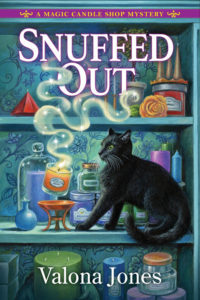 SNUFFED OUT
by Valona Jones
SNUFFED OUT
by Valona Jones
Twin sisters Tabby and Sage co-own a candle shop, but will it all go up in flames in Valona Jones’ series debut, perfect for fans of Amanda Flower and Bailey Cates.
30-year-old fraternal twins Tabby and Sage Winslow own The Book and Candle Shop in Savannah. Sage is hot-headed and impulsive while Tabby is calm and collected, making them the perfect partnership. When one of their customers is found murdered, from a blow to the head, that partnership is put to the test.
Blithe McAdam had been seen in a heated argument with shop clerk Gerard, which immediately makes him suspect number one. The twins are convinced of Gerard’s innocence and start digging into Blithe’s past. But no one is cooperating. The neighbor who found the body isn’t talking, medical examiner Quig won’t give any details about the autopsy, and nasty rumors begin surfacing about the drowning of Blithe’s father years earlier—evidence that could seal Gerard’s fate.
Tabby and Sage dig desperately for the truth. But it’s not only their friend who’s in peril. With the clock ticking, the twins find themselves in the grip of an unseen and deadly energy that has seeped into their midst—and in the sights of a ruthless killer.
Links to purchase the book:
Kindle https://www.amazon.com/dp/B09XM5PKP7/
Nook https://www.barnesandnoble.com/w/snuffed-out-valona-jones/1141345375?ean=9781639102068
Kobo https://www.kobo.com/us/en/ebook/snuffed-out-2
Amazon hardcover https://www.amazon.com/dp/1639102051/
Barnes & Noble hardcover https://www.barnesandnoble.com/w/snuffed-out-valona-jones/1141345375?ean=9781639102051
Bio:
Valona Jones writes paranormal cozy mysteries set in Southern locales. Her work blends mystery and the unexplained, along with a sprinkle of romance. A former scientist, she’s drawn to the study of personal energy. She sharpened her people-watching skills as a lifelong introvert and thankfully had a bank vault full of personal observations when she began to write fiction. Valona is a member of Mystery Writers of America and Sisters in Crime. She lives in coastal Georgia, where time and tide wait for no one. Visit her at https://valonajones.com .
The post Living our Best Lives by Maggie Toussaint, writing as Valona Jones appeared first on Debra H. Goldstein.
December 18, 2022
The Joys of Writing Something New
 By Lynn McPherson
By Lynn McPherson
It’s been a big year in my writing life. I got an agent and, very recently, signed a three-book deal with Level Best Books. I’m absolutely delighted. And relieved. Now I’m gearing up to go back to what I love to do—writing!
For me, there’s nothing more exciting than starting a new book. I even treated myself to a brand new notebook and a supersize pack of multi-color sticky notes. Woot woot!
To get things started, I went to my happy place—the library, of course. Butt in chair, pen in hand, and then… nothing. My mind went blank. It’s been so long since I’ve started a new book, I couldn’t remember what to do. Has this happened to anyone else? Yikes. Not a good feeling.
Luckily, resources were available nearby.
I borrowed How to Write a Mystery: A Handbook From Mystery Writers of America, edited by Lee Child. I’ve also begun to read Story Genius, by Lisa Cron.
After some quiet reading, I began to jot some notes. Nothing concrete, just some thoughts about the who, what, why, and how. Ideas started flow at last.
The truth is, I’d forgotten how intimidating it can be to think of writing an entire book. Then I remembered one key point: a book is not written in one long stream-of-consciousness (at least a book written by me). It’s a process. And to get it started, there’s only one thing that must be done. Sit down and write. 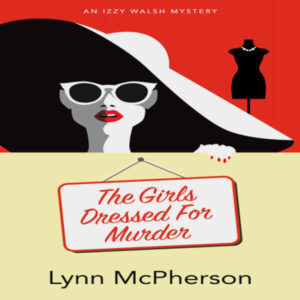
So now, I’m back to being excited. I’ve been thinking about the plot, a new list of characters to develop, scenes to plan, and dialogue to conjure up. I’d forgotten how much I love writing character arcs, coming up with a list of plausible suspects, and all the other fun steps of writing a mystery.
With my first three books, I had a very loose outline and was more of a pantser (someone who writes by the seat of their pants). This time, I’m determined to try something more structured. There are so many different ways to outline, it’ll be a fun exercise to experiment with various methods and see what works and what doesn’t.
What are your favorite parts of writing? Do you have a favorite method for outlining or are you a true pantser?
Lynn McPherson has had a myriad of jobs, from running a small business to teaching English across the globe. She has travelled the world solo, where her daring spirit has led her to jump out of airplanes, dive with sharks, and learn she would never master a surfboard. Lynn served on the Board of Directors for Crime Writers from 2019-2021. She is the author of The Izzy Walsh Mystery Series and can be found at http://lynnmcpherson.net/.
The post The Joys of Writing Something New appeared first on Debra H. Goldstein.
December 4, 2022
How the Story Came Together

By Debra Sennefelder
One question authors always get is where we get ideas from. Another top ten question is how do they plot their books? Today I’m going to share a look behind the scenes of my process.
The idea for SLEUTHING IN STILETTOS started from a few disjointed thoughts.
I wanted the mystery to revolve around another shop owner in Lucky Cove.I wanted Kelly to be dealing with the fallout of her cousin’s murder over the summer.I wanted the primary murder suspect to be someone close to Kelly.I wanted the story to take place in autumn and end right after Thanksgiving.I wanted something else, but I can’t share because it’s a spoiler.With those ideas, I was off brainstorming the story. For this stage, I typically use a notebook and find comfy places in the house (or in warmer weather, out on the patio) to jot down all the things that could happen. It can take me up to three weeks to write a complete outline for a book.
After brainstorming ideas, I get out the index cards and start filling them out. Usually, each card will have one to two sentences.
I’ll spread out the cards and start arranging them into scenes. Sometimes a few cards will become one scene because the idea isn’t enough to carry a whole scene or move the story forward.
When I have the cards in order, I take them to my computer and create a document. This will be more of a bare-bones outline. Once it’s complete, I’ll let it sit for a few days while I work on something else. For example, I might have copy edits, or I have to prepare for a release, or some admin work needs to be done.
After letting the story percolate, I return to my outline with a notebook ready to jot down notes as I read through the document. I’m fleshing out the plot, noting what the murderer is doing as my sleuth follows the clues – actual and red herrings. As I work through the outline, I’ll add character descriptions, notes about the setting, snippets of dialogue, and links to research articles.
Once the outline is finished and it could be up to twenty-five single-spaced pages, I begin writing. I take one scene at a time and keep writing until the first draft is complete. There’s no editing during this part of the process. My word count varies depending on what other work I must do, but I aim to write six days a week.
While writing the first draft of SLEUTHING IN STILETTOS, I found that a few ideas I had early on didn’t work. It can be scary, but I had confidence that new ideas would pop up. And they did. And they were so much better than what I’d initially planned.
There you have it, my process. Of course, every author’s process of plotting a story is different. What’s important is that we write the story.
If you’re an author, what’s your process of plotting? If you’re not an author, do you have any author questions you’d like to ask?
 About Sleuthing in Stilettos:
About Sleuthing in Stilettos:Kelly Quinn, owner of a high-end consignment shop, is a booster for her Long Island town’s small businesses—but now a store owner’s murder has brought big trouble . . .
Locals in Lucky Cove seem to harbor hostility toward Miranda Farrell, proprietor of a new shoe store. Nevertheless, Kelly invites her along to a Chamber of Commerce meeting. But soon afterward, Miranda’s body is found in her shop, with Kelly’s uncle—who’s had multiple public arguments with her—standing nearby. Could her uncle really have committed murder over a business dispute? Or is Miranda’s death related to her late husband’s long-ago embezzlement case?
Kelly feels compelled to investigate, despite her detective boyfriend’s objections—not to mention her commitment to promoting Small Business Saturday. But her effort to pump up sales may fall flat. After her presentation to the committee is sabotaged, the Chamber gives her the boot—and tongues start wagging. Now she has to do some fancy footwork to find the killer . . .
Debra Sennefelder is the acclaimed author of the Food Blogger Mysteries and the Resale Boutique Mystery Series. An avid reader who reads across a range of genres, mystery fiction is her obsession. Her interest in people and relationships is channeled into her novels against a backdrop of crime and mystery.
Her first novel, THE UNINVITED CORPSE (A Food Blogger mystery) was published in 2018. When she’s not reading, she enjoys cooking and baking and as a former food blogger, she is constantly taking photographs of her food. Yeah, she’s that person.
Born and raised in New York City, where she majored in her hobby of fashion buying, she now lives and writes in Connecticut with her family. She worked in retail and publishing before becoming a full-time author. Her writing companion is her adorable and slightly spoiled Shih-Tzu, Connie.
The post How the Story Came Together appeared first on Debra H. Goldstein.
November 20, 2022
The Importance of Showing Up
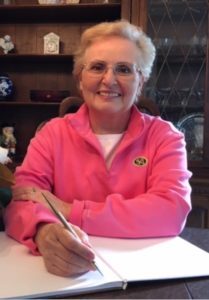 By Grace Topping
By Grace Topping
As a child, I enjoyed the stories my mother told my sisters and me at bedtime about her childhood. Sometimes her stories were happy and sometimes sad, but we were fascinated by them. Little did I realize that one of her experiences would profoundly affect me and cause me to do things throughout my life that I didn’t always want to do.
During the Depression, my mother lived at a girls’ boarding school. One of her teachers, Miss Jones, had been a missionary in China and regaled the class with stories of her experiences there. Later, she invited the students to her home to view the items she had collected during her travels. When the day arrived, the warm and sunny weather tempted my mother to skip the event to enjoy the day outdoors. But thinking better of it, she went to Miss Jones’s house.
When she arrived, she discovered Miss Jones had lovingly displayed the items that meant so much to her. She had also set the table with a beautifully decorated cake and other refreshments. My mother was so glad she went—because no one else showed up. My sisters and I gasped. What if our mother hadn’t gone? No one would have been there. How disappointing that would have been for Miss Jones, who had gone to so much trouble.
After that, whenever I was invited somewhere and tempted not to go, the thought always haunted me: what if no one shows up? So I went out on bright sunny days and trudged out on cold winter nights to a variety of events when many times I wanted to be elsewhere. And, yes, there were times when lots of people were at the event, but also times when my presence helped.
As the years went by, I found this commitment spilling into other areas of my life, especially when I decided to write a mystery. What if I hadn’t joined professional writing groups and showed up at their meetings? What if I hadn’t attended the book signing of debut authors when they sat there looking lonely?
Recently, I saw an announcement that an author I know was to speak at a local book festival. I knew she was coming from out of town for the event. What if nobody showed up? Other than the author’s family members who were there, I was one of five other people in the audience. Sometimes it’s good to show up.
How about you? Have there been times you were glad you showed up?
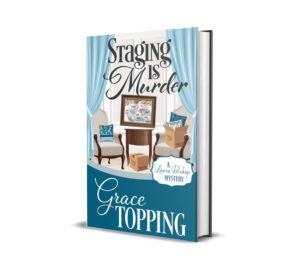 Grace Topping is a USA Today bestselling author and Agatha Award Finalist. A recovering technical writer and IT project manager, she was accustomed to writing lean, boring documents. Let loose to write fiction, she is now creating murder mysteries and killing off characters who remind her of some of the people she dealt with during her career. Fictional revenge is sweet. She is the author of the Laura Bishop Mystery series. Grace is the former vice president of the Chesapeake Chapter of Sisters in Crime (SINC), a steering committee member of the SINC Guppies, and a member of Mystery Writers of America. She lives with her husband in Northern Virginia.
Grace Topping is a USA Today bestselling author and Agatha Award Finalist. A recovering technical writer and IT project manager, she was accustomed to writing lean, boring documents. Let loose to write fiction, she is now creating murder mysteries and killing off characters who remind her of some of the people she dealt with during her career. Fictional revenge is sweet. She is the author of the Laura Bishop Mystery series. Grace is the former vice president of the Chesapeake Chapter of Sisters in Crime (SINC), a steering committee member of the SINC Guppies, and a member of Mystery Writers of America. She lives with her husband in Northern Virginia.
The post The Importance of Showing Up appeared first on Debra H. Goldstein.
November 6, 2022
My Love of Bad Guys
 By Annette Dashofy
By Annette Dashofy
I grew up at a time when Westerns were all the rage on TV. Gunsmoke, Bonanza, The Big Valley to name a few. My dad and I watched them all. One of my favorites was a series titled Alias Smith and Jones. In it, two of the most successful outlaws in the history of the West decide to go straight. Or try to. As a teen, I wrote several “novels” about these characters—novels written longhand, in pencil, in lined spiral-bound notebooks—what we now call fan fiction.
At the very beginning of the pilot episode of Alias Smith and Jones, a narrator said:
Into the West came many men. Some were good men and some were bad men. Some were good men with some bad in them. And some were bad men with some good in them…
Now, almost a half-decade later, I hold those words close to my heart. I no longer write fan fiction or westerns. I write traditional mysteries. And as I create my cast of characters for each book, I fall back on the opening narration from that old show.
As writers, we’re frequently told to create flawed heroes. Nobody’s perfect, after all. Too often, however, we forget the flip side of the coin. Our villains shouldn’t be perfectly horrible either.
Yes, evil does exist in the world. But I much prefer to write about a bad guy who has some good in him. My favorite villain of all I’ve written (and I can’t tell you which one without spoiling that book) did some truly awful things, but his reasons were understandable. Like another character from my youth, the Grinch Who Stole Christmas, his heart grew as the story progressed. By the time I reached the climatic final scenes, I was heartbroken. I needed to kill this character, to have justice served. Could I possibly find a way to keep him around? He’d begun to seek redemption. Plus, I genuinely liked him! But no. He’d done too much, gone too far, and had to pay for his misdeeds.
Darn it.
Our villains need to have a good reason, at least in their minds, for doing what they do. They need motivation. Maybe they’re righting their own perceived wrongs.
Here’s another bit of wisdom I carry as I create villains:
Everyone is the hero of their own story.
In the villain’s mind, he is absolutely right and justified in doing what he does. He has his own internal dialogue about the victim, that rat bastard who doesn’t deserve to live. And about your hero, that SOB who’s trying to keep him from completing his mission.
Too often, we don’t spend enough time getting to know our villain. We take days, weeks, months developing our heroes and their sidekicks. A little less time, perhaps, fleshing out our victim. But too often, the killer is just a cardboard Bad Guy. Think Snidely Whiplash.
I believe it was Erle Stanley Gardner who advised that we should write from the viewpoint of the hero but PLOT from the viewpoint of the villain. (If this should be attributed to someone other than Mr. Gardner, I apologize.) For me, this is sage advice. I can’t know what the hero is up against, what he finds at a crime scene, what obstacles he faces, without knowing what the villain is doing off stage. Any time I run into “writer’s block,” I know it’s because I need to spend some time inside the head of the bad guy.
And if I’ve developed him with a little bit of good in him and understand his side of the story—his motivation—I rather enjoy that time. Bad guys can and should be fascinating.
 About Where The Guilty Hide (Detective Honeywell Mystery #1) coming January 20, 2023
About Where The Guilty Hide (Detective Honeywell Mystery #1) coming January 20, 2023On the shore of Lake Erie, Pennsylvania, a body lays half hidden, the waves slowly moving it with the rising tide…
In the early morning mist, freelance photographer Emma Anderson takes pictures of the rocky coastline. She moved to Erie to escape a past that haunts her but the last thing she expects to capture is a dead body.
Erie City Police Detective Matthias Honeywell has been investigating a spate of home invasions but when one of the robbery victims turns up dead, his case evolves into homicide. Emma’s first encounter with Detective Honeywell leaves her shaken when he reminds her of her ex-fiancé-turned-stalker. Matthias misinterprets Emma’s anxiety and suspects she knows more than she’s letting on.
With the threat of another murder and no obvious leads, will Emma and Matthias overcome their mutual distrust and work together to capture a killer?
About the AuthorAnnette Dashofy is the USA Today best-selling author of twelve novels including the Agatha nominated Zoe Chambers mystery series about a paramedic/deputy coroner in rural Pennsylvania’s tight-knit Vance Township. Her standalone, Death By Equine, set in the world of Thoroughbred horseracing, is a finalist for the Dr. Tony Ryan Book Award. Her first in a new series, Where the Guilty Hide, comes out in January 2023 and is available for pre-order now.
Pre-order links for Where the Guilty Hide:
The post My Love of Bad Guys appeared first on Debra H. Goldstein.
October 30, 2022
Halloween vs. Valentine’s Day
 By Judy Penz Sheluk
By Judy Penz Sheluk
This post is scheduled for Halloween, which amuses me, because I’ve never been much of a Halloween person. Even as a kid, I dreaded the thought of dressing up and knocking on neighbor’s doors asking for candy, then coming home and watching while my dad inspected every piece for signs of tampering before a single morsel could cross my lips.
As a teenager, I transitioned from door-to-door canvassing to at-home Halloween parties. I recall one party where I went with my boyfriend of the day, he the farmer, me the wife. My costume consisted of painting some freckles on my face and putting my hair in braids. There may have been a plaid shirt and blue jeans involved. Possibly a tuft or two of hay. Imagination, not so much.
Later, as a homeowner, I found myself on the giving end of the tradition. This caused me no end of stress. If I bought things I liked (chocolate), I lacked the willpower not to eat it before the big night arrived. If I bought things I didn’t care for (licorice or potato chips), I would be stuck with them if I couldn’t give it all away.
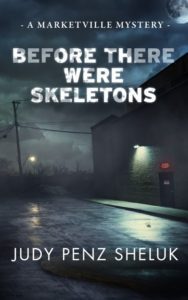 First world problems, I know, but my dislike of Halloween in general is the main reason that none of my books are centered around it. Valentine’s Day, on the other hand, has played a significant role in two of my books: Skeletons in the Attic, book 1 in my Marketville Mystery series, and the just released Before There Were Skeletons.
First world problems, I know, but my dislike of Halloween in general is the main reason that none of my books are centered around it. Valentine’s Day, on the other hand, has played a significant role in two of my books: Skeletons in the Attic, book 1 in my Marketville Mystery series, and the just released Before There Were Skeletons.
In Skeletons in the Attic, Calamity (Callie) Barnstable, my protagonist, 36 at the time, inherits a house in Marketville from her father, who has died in an “unfortunate” occupational accident. The catch? She must move into the house, a house she didn’t know existed, and find out the truth about her mother, Abigail Osgoode Barnstable, who disappeared on Valentine’s Day 1980, when Callie was six.
In Before There Were Skeletons, Callie, now on the cusp of turning 43, has been hired to find out the whereabouts of an eighteen-year-old single mother who disappeared on Valentine’s Day 1995. Her client? The infant left behind, now twenty-eight.
So why Valentine’s Day, you might be asking. After all, isn’t that a day for love and romance? Maybe for some. For me, not so much. My first boyfriend (not the farmer) dumped me by phone (by phone!) on Valentine’s Day, and this after I’d been expecting a ring, having spent hours looking for the perfect card for him (two porcupines kissing with the message, “I love you so much it hurts.” – who says fate isn’t ironic?). Decades later, I was able to use that memory for a scene in Skeletons in the Attic, and it was wonderfully cathartic.
 But back to Before There Were Skeletons, which is a story not only of the missing mother, but of Callie’s attempts to come to terms with her unresolved issues surrounding her own mother. And so, Valentine’s Day just seemed like the right place to start. Here’s a brief excerpt from Chapter 2, told from Callie’s point of view:
But back to Before There Were Skeletons, which is a story not only of the missing mother, but of Callie’s attempts to come to terms with her unresolved issues surrounding her own mother. And so, Valentine’s Day just seemed like the right place to start. Here’s a brief excerpt from Chapter 2, told from Callie’s point of view:
Rule number one. Don’t ask a question if you don’t want an honest answer.
I asked Ben anyway. “I take it we’re still fighting?”
“We’d have to be in a relationship to be fighting.”
And there you had it. Ben Benedetti was the man I thought I might have a future with, at least until now. It would appear the Barnstable Valentine’s Day curse was alive and well.
At least he didn’t kiss me on the forehead on his way out.
I hated when men did that.
About the book: The last time anyone saw Veronica Goodman was the night of February 14, 1995, the only clue to her disappearance a silver heart-shaped pendant, found in the parking lot behind the bar where she worked. Twenty-seven years later, Veronica’s daughter, Kate, just a year old when her mother vanished, hires Past & Present Investigations to find out what happened that fateful night.
Calamity (Callie) Barnstable is drawn to the case, the similarities to her own mother’s disappearance on Valentine’s Day 1986 hauntingly familiar. A disappearance she thought she’d come to terms with. Until Veronica’s case, and five high school yearbooks, take her back in time…a time before there were skeletons. Universal Book Link: https://books2read.com/u/mqXVze.
About the Author
A former journalist and magazine editor, Judy Penz Sheluk is the bestselling author of two mystery series: The Glass Dolphin Mysteries and the Marketville Mysteries. Her short crime fiction appears in several collections, including the Superior Shores Anthologies, which she also edited.
Judy is a member of Sisters in Crime, International Thriller Writers, the Short Mystery Fiction Society, and Crime Writers of Canada, where she served as Chair on the Board of Directors. She lives in Northern Ontario on the shores of Lake Superior. Find her at judypenzsheluk.com.
The post Halloween vs. Valentine’s Day appeared first on Debra H. Goldstein.
October 23, 2022
Grammar Crimes
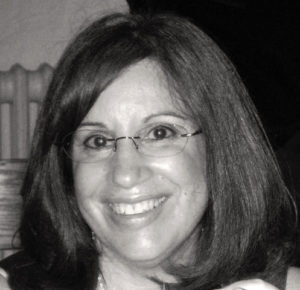 By Lois Winston
By Lois Winston
Do you have a grammar pet peeve? I do, thanks to Peggy Riley Hughes, my seventh and eighth-grade English teacher. Because of Mrs. Hughes, I cringe whenever I hear or read poor grammar. If the world had more Peggys, I’d cringe a lot less.
To boldly go where no man has gone before. Remember that opening from Star Trek? Cringe-worthy! Gene Rodenberry obviously didn’t have Peggy Riley Hughes as an English teacher. If he had, he never would have split his infinitive.
Sadly, because there are so few English teachers like Peggy Riley Hughes, the Oxford English Dictionary did the unthinkable years ago—they declared it okay to split infinitives. Horrors! What would Peggy say?
Writers have license to take liberties with their writing. When I write dialogue, I don’t necessarily write in perfectly formed sentences because people don’t always speak in perfectly formed sentences. We often use sentence fragments. Our characters rarely speak using perfect grammar. That’s okay. We want them to sound realistic, not stilted. Style will also often dictate that sentence fragments be used in narrative.
There are, however, grammar rules that should never be broken.
Anyone who wants to be a writer, needs a firm grasp of the English language. Why is this important? Won’t the editor correct whatever needs correcting? Once upon a time that may have been true. However, these days editors don’t have the luxury of time to mollycoddle an author with a great story idea but a poor command of the English language. There are plenty of other well-written manuscripts at the editor’s fingertips.
The grammar error that makes me cringe the most, is the misuse of pronouns. For some reason, many people think substituting the nominative for the objective sounds more intelligent, no matter that it’s wrong. I see very well-educated people making this mistake all the time in their speaking and their writing. It makes me wonder if grammar is even being taught in schools these days.
If English class is a distant memory, here’s a nominative/objective refresher:
Nominative Pronouns: I, you, he, she, it, we, they, and who.
Objective Pronouns: me, you, him, her, it, us, them, and whom.
The nominative is always used as the subject of the sentence. The objective is always used in the predicate of a sentence and pairing with a direct object.
Think about it: You wouldn’t say, “John helped I” or “She gave the papers to I,” so why would you say, “John helped Suzie and I” or “She gave the papers to John and I”? It makes no sense, right?
Please consider your pronouns in your speaking and writing. I fear that whenever someone misuses them, Peggy Riley Hughes turns over in her grave. Help give the poor woman a much-deserved rest!
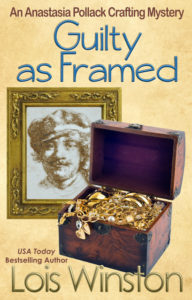 Guilty as Framed
Guilty as Framed
An Anastasia Pollack Crafting Mystery, Book 11
When an elderly man shows up at the home of reluctant amateur sleuth Anastasia Pollack, she’s drawn into the unsolved mystery of the greatest art heist in history.
Boston mob boss Cormac Murphy has recently been released from prison. He doesn’t believe Anastasia’s assertion that the man he’s looking for doesn’t live at her address and attempts to muscle his way into her home. His efforts are thwarted by Anastasia’s fiancé Zack Barnes.
A week later, a stolen SUV containing a dead body appears in Anastasia’s driveway. Anastasia believes Murphy is sending her a message. It’s only the first in a series of alarming incidents, including a mugging, a break-in, another murder, and the discovery of a cache of jewelry and an etching from the largest museum burglary in history.
But will Anastasia solve the mystery behind these shocking events before she falls victim to a couple of desperate thugs who will stop at nothing to get what they want?
Buy Links for paperback, hardcover, and various e-tailers can be found here.
Bio: USA Today and Amazon bestselling and award-winning author Lois Winston writes mystery, romance, romantic suspense, chick lit, women’s fiction, children’s chapter books, and nonfiction under her own name and her Emma Carlyle pen name. Kirkus Reviews dubbed her critically acclaimed Anastasia Pollack Crafting Mystery series, “North Jersey’s more mature answer to Stephanie Plum.” In addition, Lois is a former literary agent and an award-winning craft and needlework designer who often draws much of her source material for both her characters and plots from her experiences in the crafts industry. Learn more about Lois and her books at her website www.loiswinston.com where you can also sign up for her newsletter and follow her on various social media sites.
The post Grammar Crimes appeared first on Debra H. Goldstein.
October 9, 2022
Surprise! It’s a Sequel!
 By Bethany Maines
By Bethany MainesIn this day of Marvel Universes and streaming limited– run shows, no, it’s not a surprise that it’s a sequel. It seems like everyone is embracing the sequel world-building ethos. But how is it that Marvel is thriving while DC can’t seem to figure out how to connect… anything? Or, for that matter, how does a novelist keep their world churning along? Well, if you’re this novelist, the answer is… (drumroll) spreadsheets. That’s right, this world and the fictional world all run on Excel. And a lot of imagination. I have written four series and assisted in building one shared universe, so I’ve figured out a few systems to make a series cohesive.
For the universe I share with two other authors, we have to agree on everything from technology to swear words, spelling, and historical facts. There’s an ever-expanding word doc and a spreadsheet that tracks names, unique vocabulary, and the books in which the words appear. But if you’ve ever met an author, you’ll know that updating “whenever we like” turns out to be the seventh of Nevermber. So there has been some scrambling to ensure we don’t let the others down, but in general, we have benefitted from sharing brain space to create a vibrant, textured universe. (Check out the Galactic Dreams books if you enjoy science-fiction, fairy tale retellings, and want to see our results.)
For each of my series novels which include The Carrie Mae Mysteries, the San Juan Island Mysteries, the Shark Santoyo Crime Series, and The Deveraux Legacy Series, I’ve come to recognize a few keys to success. Rule #1 – Know where you’re going. It really helps to know how you want the series to end when you start writing, and can write through the stories with that in mind.
Now, do I always follow this rule? Absolutely not. The San Juan Islands Mysteries feature Tish Yearly and her grandfather, Tobias, solving mysteries. Each novel is a singular adventure, and while character arcs continue from book to book, there is no overarching story. Tish and Tobias find a dead body, help their island friends, and solve the mystery (usually while arguing). The End. But in general, that is what the readers want from an almost cozy mystery full of quirky Pacific Northwest island residents.
But with the Shark and Deveraux Legacy series, it’s the characters that readers love, and they want MORE of those characters. For Shark and the Deverauxes, the books leading up to the final story have an adventure per book but also share an overarching plot line that links the entire series. But by the time we get to the last book, the readers know the players and the bad guys, so the challenge becomes wrapping up the series in a satisfying conclusion. This is a bit easier with the Deveraux Legacy (final book releases October 18!), which features the four cousins of the Deveraux Family, and now that I’m out of cousins, it gets a little hard to come up with a new story. But the real problem with writing a series where I know the end is that I know that sooner or later, I have to say goodbye to my fictional friends. And I haven’t figured out any good tips for saying goodbye just yet.
About The Fallen Man (Deveraux Legacy #4):https://books2read.com/fallenman/
When orphan and convicted felon Jackson Zane (now Deveraux) realized that he was part of the wealthy Deveraux family, he thought he’d found his proverbial happily ever after. But he quickly realized that each of his three new cousins had problems. For the last seven years, Jackson has dedicated himself to fixing and protecting his new family, all while ruling out love for himself. Katie St. Cloud, the in debt up to her eyeballs bartender-slash-model, has been on the run from love too. But when she meets Jackson, Katie thinks she’s met the perfect definitely-not-a-boyfriend of her dreams. It’s only when the Deveraux family’s enemies come crashing into her life that Jackson and Katie have to face the truth—they may be in love, and that may not be enough. And as the family faces one last threat, Jackson finds that saving the Deverauxes might just mean giving up on love for good. But the Deveraux cousins aren’t going down without a fight, and Evan, Aiden, and Dominique set out to fix their mistakes, save Jackson, and cement the Deveraux Legacy once and for all.
Meet the Author:Bethany Maines is the award-winning author of the Carrie Mae Mysteries, San Juan Islands Mysteries, Shark Santoyo Crime Series, and numerous short stories. When she’s not traveling to exotic lands, or kicking some serious butt with her black belt in karate, she can be found chasing her daughter or glued to the computer working on her next novel. You can also catch up with her on Twitter, Facebook, Instagram, and BookBub.
The post Surprise! It’s a Sequel! appeared first on Debra H. Goldstein.
September 12, 2022
Do You See What I See? by James M. Jackson
 By James M. Jackson
By James M. Jackson
Answer me this: It’s summer. I point to any sugar maple in the Upper Peninsula of Michigan forest my protagonist Seamus McCree calls home and ask, what color are its leaves?
We all know the answer: green.
Yet, what I cannot know is if the “green” you see is the same “green” I see. We were both taught by parents, teachers, books that sugar maple leaves in the summer are green. The grass on our lawns is also green (if we watered and fertilized, otherwise it might be brown). We can agree on the physics: light reflecting from a particular leaf has the same wavelength regardless of the viewer. Differences arise when those light waves reach our eyes, and our brains interpret them.
My son’s eyes have a higher proportion of green cones than normal, which, doctors tell me, means he sees green more brightly than I. That may explain why his favorite clothing as a toddler were his green Oshkosh B’gosh overalls. (Or maybe they fit better than anything else.) But it doesn’t tell me what he sees, nor can he know what I see. And while we have a physical explanation of why my son and I should see differently, the fact is, I don’t know what you see when you look at a leaf either.
It’s not simply our physical differences that cause us to experience the world differently. We process and evaluate information based on our previous experiences. Writing from a character’s point of view requires me to put on their blinders, employ their filters, experience and describe the world as the character would. Seamus is a numbers guy, and he asks questions like: “On a scale of one to ten . . .” He thinks more often than he feels. He enjoys being outdoors, and he particularly enjoys birdwatching. Even if he’s not actively birdwatching, he notices their colors, their mannerisms, their songs, and when they are quiet. His brain’s overload filter lets in all things bird.
Others might block out the birds and notice instead faint tracks in the dirt, a broken twig, crushed grass from the passing of an animal. Still others might ignore nature altogether, worried only about mosquitoes and ticks and making it back home in time for their daily glass of wine without wolves, bears or cougars attacking them.
Different perspectives can lead to conflict, even death. Sometimes they provide a humorous character insight. That happens in the “eagle subplot” in Granite Oath, the seventh Seamus McCree novel. The subplot kicks off with Megan, Seamus’s eight-year-old granddaughter announcing, “Grampa Seamus. We’re training an eagle.”
Later, after Seamus witnesses Megan and her friend Valeria calling in a family of eagles to grab fish they have left, Megan explains how it started:
“We accidentally left a fish on the dock and saw the eagle grab it.” She slid me a look. “Pier. You told me. Piers stay in the water, docks come out for winter. We did a science experiment and left one on purpose. The fish have to be keepers. They won’t come for the little ones.”
Seamus thinks to himself that the kids aren’t training an eagle, the eagle is training the kids.
Same event, different perspectives. I’m sure you’ve experienced something similar, and I’d loved to hear about it in the comments.
* * *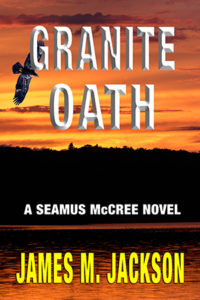 Mini-bio:
Mini-bio:
James M. Jackson authors the Seamus McCree series. Full of mystery and suspense, these domestic thrillers explore financial crimes, family relationships, and what happens when they mix. August 2022 saw publication of the 7th novel in the series, Granite Oath. (Click here for information and purchase links.)
Jim splits his time between the wilds of Michigan’s Upper Peninsula and the city life in Madison, WI. You can find more information about Jim and his books at https://jamesmjackson.com or contact him via email.
The post Do You See What I See? by James M. Jackson appeared first on Debra H. Goldstein.
August 28, 2022
The Deep Thrill by Barbara Kyle
 By Barbara Kyle
By Barbara Kyle
Mystery. Thriller. Romance. Science Fiction. Horror. The publishing industry uses these labels for what they call “genre” novels. Literary critics often dismiss genre novels as lightweight, even trivial.
But are they?
After all, it can be argued that even classic literary novels fall within the bounds of some genre. Jane Austen’s Pride and Prejudice is a romance. Dostoevsky’s Crime and Punishment is a psychological thriller. Mary Shelley’s Frankenstein is horror. Jules Verne’s Twenty Thousand Leagues Under the Sea is science fiction. The Name of the Rose, the intellectual debut novel of Umberto Eco, is a murder mystery.
And, my goodness, what writer wouldn’t want to be classed with Dostoevsky?
As the author of several thrillers, let me share with you what I believe is special – in fact, important – about this particular genre.
It’s often said that a good thriller is like a roller-coaster ride. That’s true enough, because the genre is about high stakes, countdowns, and suspense, and every compelling thriller delivers this kind of excitement.
But the most satisfying thrillers deliver more: an exciting story that also explores complex issues. This kind of story has something meaningful to say about our world. It takes the reader away from the amusement park and sends them on a voyage – an exhilarating journey into a different way of thinking.
I call it Deep Genre.
The job of Deep Genre is to take readers beyond their expectations. To give them an insight they never saw coming. “Insight” literally means seeing the truth through and under the surface of things. It’s the serious novelist’s job to challenge not only readers’ expectations, but also their received wisdom, their acceptance of society’s status quo.
At its heart, Deep Genre is always about confronting power.
Charles Dickens knew this when he used his immensely popular novels to hold a mirror up to the horrors that working-class people suffered under unfettered capitalism in nineteenth-century England.
John Grisham’s popular thrillers often feature a “little guy” up against some form of corporate bully.
John le Carré’s literary thrillers train his unflinching focus on the corrosive corporate and political powers who manipulate our lives.
Denise Mina, a master of “noir” crime fiction, reveals the raw wounds that Glasgow’s poor and powerless suffer, and she creates female characters who are resilient and resourceful.
The most compelling thrillers lead to a climax in which the main character learns something profound about themself and the world they live in. If they don’t, they remain unenlightened, adolescent. They haven’t grown. So neither can the reader. In other words, the roller-coaster ride is all you get.
A fine thriller – or a deft murder mystery – may end in tragedy or, more commonly, with justice prevailing, or sometimes a bittersweet blend of both. Whatever the outcome, readers embrace the richness of Deep Genre and welcome the experience. We need it.
Because it’s not the roller-coaster ride that satisfies the soul. It’s the voyage.
# # #
Barbara Kyle is the author of the bestselling Thornleigh Saga historical novels and acclaimed thrillers. Over half a million copies of her books have been sold worldwide. Her most recent novel is The Man from Spirit Creek. Her upcoming novel The Deadly Trade, a murder mystery, will be published in fall 2023. Visit Barbara at https://www.barbarakyle.com/ and on Twitter: @BKyleAuthor
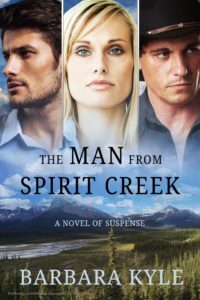 About The Man from Spirit Creek: Oil executive Liv Gardner sets out to entrap farmer Tom Wainwright who is sabotaging her company’s rigs. But when Tom is accused of a murder he didn’t commit, Liv must face the fact of her own corrupting power. Only by giving up everything to save him can she find her own redemption.
About The Man from Spirit Creek: Oil executive Liv Gardner sets out to entrap farmer Tom Wainwright who is sabotaging her company’s rigs. But when Tom is accused of a murder he didn’t commit, Liv must face the fact of her own corrupting power. Only by giving up everything to save him can she find her own redemption.
“A stunning thriller…Lost sleep as I couldn’t put this one down.” – Amazon review
“Full of twists that kept me wanting more…a mix of thriller, mystery, romance, and redemption.” – Goodreads review
Buy The Man from Spirit Creek.
The post The Deep Thrill by Barbara Kyle appeared first on Debra H. Goldstein.



